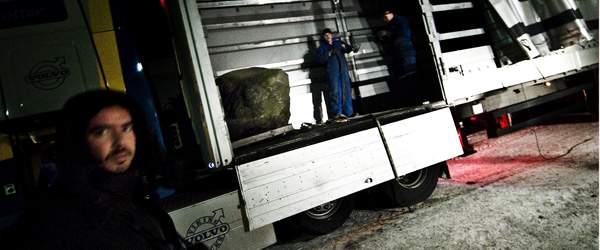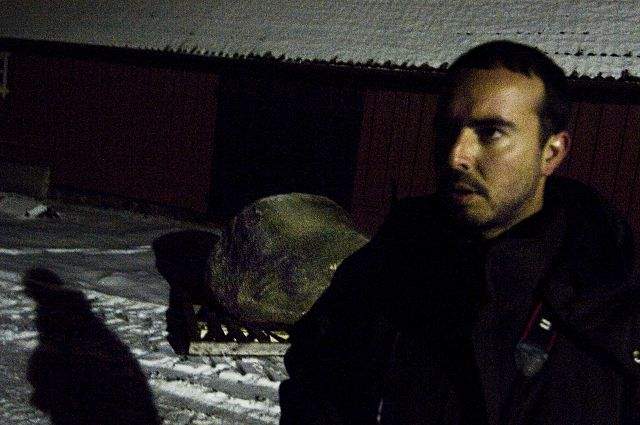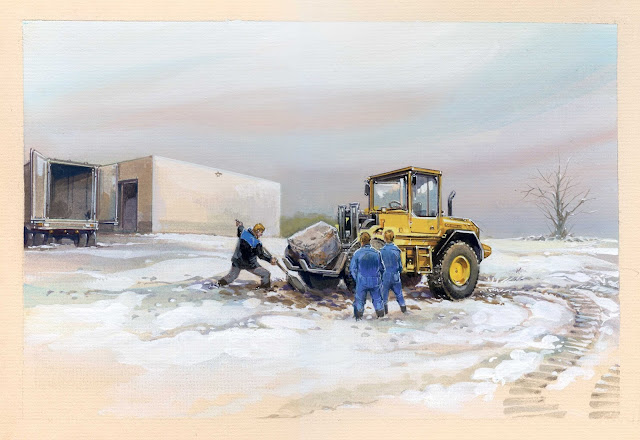Cover Story, November 2024: Max Andrews on Robert Smithson’s text “Aerial Art” (1969)
Fri, Nov 1 2024NEW MONTH
NEW MONTHLY COVER STORY
The Scholarly Text Program regularly commissions thinkers from various disciplines to write 1,200 words on single artworks by Nancy Holt and/or Robert Smithson. These essays explore how Holt and Smithson’s ideas resonate through contemporary artistic and cultural production, covering topics ranging from geology to ecology, poetry, and beyond.
Read Mariana Cánepa Luna’s recently published essay on Nancy Holt’s site-responsive installation “Ventilation System” (1985–1992) also part of the Scholarly Text Programme’s Chapter 7.
Thank you to Lisa Le Feuvre, Executive Director of the Holt/Smithson Foundation, for the kind invitation to contribute to the foundation’s growing archive, and to William T. Carson, Program Manager and Assistant Curator, for the research assistance.
Abstract:
Max Andrews’ essay delves into Robert Smithson's seminal article "Aerial Art" (1969), which outlines his earthworks proposals for the Dallas-Fort Worth Regional Airport and those of Carl Andre, Robert Morris, and Sol LeWitt. Andrews examines the historical context, including the growth of air travel and global art networks. Importantly, the essay underscores the sustained multi-decade increase in CO2 emissions from air travel and its significant contribution to the climate crisis.
Keywords:
Robert Smithson, Aerial Art, 1969, Studio International, Artforum, Anthropocene, Charles Jencks, postmodernism, Dallas-Fort Worth Regional Airport, Tippetts–Abbett–McCarthy–Stratton, earthworks, Carl Andre, Robert Morris, and Sol LeWitt, site-specificity, Boing 747, Spiral Jetty, CO2 emissions, frequent flying, transnational art world, contemporary art, decarbonization, exhibition-making, curatorial hypermobility, Harald Szeemann, air travel, global mobility, low-carbon footprint art production, multinational museum brands, biennial model, Fernand Braudel, Gustav Metzger, Reduce Art Flights, Paris Agreement, 2030, global warming.
How to cite:
Andrews, Max, “Frequent Flyers: Robert Smithson’s “Aerial Art,” 1969”, Holt/Smithson Foundation: Scholarly Texts Chapter 7 (October 2024). ISBN: 978-1-952603-36-5
→ RELATED CONTENT:
- Other writing
- Looking back – Visiting Robert Smithson's “Spiral Jetty” (1970) on 7 September 2004, 7 Sep 2014
- Publication “Robert Smithson: Art in Continual Movement” (Alauda Publications, 2012) includes an essay by Max Andrews, 28 Mar 2012
- Lecture by Max Andrews "From Spiral to Spime: Robert Smithson, the ecological and the curatorial", 13 March, 2pm, Lecture Theatre 1, Royal College of Art, London, 12 March 2012
- Robert Smithson's “Broken Circle/Spiral Hill Revisited” (1971–2011) and The Land Art Contemporary programme, 14 September 2011
- Archive of Monthly Cover Stories
- Cover Story, October 2024: Nancy Holt “Ventilation System”, 1 Oct 2024
- Cover Story, September 2024: THE CREST OF A WAVE, 2 Sept 2024
- Cover Story, July-August 2024: Rosa Tharrats, Curtain Call, 1 July 2024
- Cover Story, June 2024: TERENCE GOWER—DIPLOMACY, URBANISM, URANIUM, 3 June 2024
- Cover Story, May 2024: Richard Serra & Anne Garde—Threats of Paradise, 30 Apr 2024
- Cover Story, May 2024: Richard Serra & Anne Garde—Threats of Paradise, 30 April 2024
- Cover Story, April 2024: In Progress–Iratxe Jaio and Klaas van Gorkum, 2 April 2024
- Cover Story, March 2024: Dibbets en Palencia, 4 March 2024
- Cover Story, February 2024: Climate Conscious Travel to ARCOmadrid, 1 February 2024
- Cover Story, January 2024: Curating Lab 2014–Curatorial Intensive, 2 Jan 2024
- Cover Story, December 2023: Ibon Aranberri, Partial View, 2 Dec 2023
- Cover Story, November 2023: Surucuá, Teque-teque, Arara: Daniel Steegmann Mangrané, 2 Nov 2023
Cover Story, October 2024: Nancy Holt “Ventilation System”
Tue, Oct 1 2024NEW MONTH
Mariana Cánepa Luna of Latitudes was commissioned to write an essay on a work by American artist Nancy Holt (1938–2014) for the Holt/Smithson Foundation’s Scholarly Text Program.
Throughout her career, Holt presented four iterations of “Ventilation System”: at Temple Gallery, Philadelphia; and Palladium, New York (both in 1985); at the Tampere Art Museum, Finland; and at the Guild Hall Museum in East Hampton, New York (both in 1992). Posthumously, the installation has been presented on three occasions: at Bildmuseet, Umeå, Sweden; Queensland Art Gallery | Gallery of Modern Art, Brisbane, Australia (both in 2022); and most recently at MACBA Museu d’Art Contemporani de Barcelona, Spain (2023).
The Scholarly Text Program regularly commissions thinkers from various disciplines to write 1,200 words on single artworks by Nancy Holt and/or Robert Smithson. The authors explore how Holt and Smithson’s ideas resonate through artistic and cultural production in the present, exploring topics ranging from geology to ecology, poetry, architecture, science fiction, public art, sculpture, drawing, film, exhibition histories or philosophy. The Scholarly Text Program will publish two essays on each work, presenting differing opinions and approaches. Each new essay includes images selected by the author, a short bibliography, citation references, endnotes pointing to the author’s references and an ISBN.
Stay tuned for Max Andrews’ upcoming contribution on Smithson’s article “Aerial Art” (1969) next month.
Thank you to Lisa Le Feuvre, Executive Director of the Holt/Smithson Foundation, for the kind invitation to contribute to the foundation’s growing Scholarly Texts Program archive and to William T. Carson, Program Manager and Assistant Curator, for the research assistance. Extended gratitude to Chicago-based artist Nick Raffel for the insightful online studio visit and to Maxwell Graham Gallery, New York.
- Archive of Monthly Cover Stories
- Other writing by Mariana Cánepa Luna
- Looking back – Visiting Robert Smithson's “Spiral Jetty” (1970) on 7 September 2004, 7 Sep 2014
- Publication “Robert Smithson: Art in Continual Movement” (Alauda Publications, 2012) includes an essay by Max Andrews, 28 Mar 2012
- Cover Story–September 2024: Cover Story, September 2024: THE CREST OF A WAVE, 2 Sept 2024
- Cover Story–July-August 2024: Rosa Tharrats, Curtain Call, 1 July 2024
- Cover Story, June 2024: TERENCE GOWER—DIPLOMACY, URBANISM, URANIUM, 3 June 2024
- Cover Story, May 2024: Richard Serra & Anne Garde—Threats of Paradise, 30 Apr 2024
- Cover Story, April 2024: In Progress–Iratxe Jaio and Klaas van Gorkum, 2 April 2024
- Cover Story, March 2024: Dibbets en Palencia, 4 March 2024
- Cover Story, February 2024: Climate Conscious Travel to ARCOmadrid, 1 February 2024
- Cover Story, January 2024: Curating Lab 2014–Curatorial Intensive, 2 Jan 2024
- Cover Story, December 2023: Ibon Aranberri, Partial View, 2 Dec 2023
- Cover Story, November 2023: Surucuá, Teque-teque, Arara: Daniel Steegmann Mangrané, 2 Nov 2023
- Cover Story, October 2023: A tree felled, a tree cut in seven, 2 October 2023
LaPublika – Public sphere laboratory for artistic research, consonni, Donostia, 10–11 November 2015
Mon, Nov 2 2015"Public sphere here is understood as spaces considered to be public (the street, the square, the city), as well as the internet or the communications media, and the mechanisms with which we participate in managing what is common (language, rites, norms, the aesthetic of collective processes). At a time when new social and civic paradigms are arising, LaPublika seeks to provide a framework of work and reflection upon those processes." (....) "In addition to the presence-based programme, all the activities have their version in podcast format on LaPublika’s radio-web, the central hub of the project, which is also backed up by programming involving interviews, radio spots and sound pieces."
For the public lecture on November 11, Latitudes will forgo a chronological account of its projects of the last decade, and instead attempt various transects through its curatorial projects determined by the public sphere, raw materials and their transformation. From the zinc which led to an Esperanto micro-nation, to the air of a Beijing shopping centre, or the dead trees of printed news, Latitudes will join some traits and ideas around “human resources”, extractive modernity, obsolescence and the carbon cycle.
RELATED CONTENT:
- More about Consonni
- More about LaPublika
- Launch of LaPublika to the basque press
- Video de Latitudes sobre el taller desarrollado en LaPublika.
Looking back – Visiting Robert Smithson's 'Spiral Jetty' (1970) on 7 September 2004
Sun, Sep 7 2014Related posts:
- Lecture by Max Andrews "From Spiral to Spime: Robert Smithson, the ecological and the curatorial", 13 March, 2pm, Lecture Theatre 1, Royal College of Art, London (12 March 2012)
- Publication "Robert Smithson: Art in Continual Movement" (Alauda Publications, 2012) includes an essay by Max Andrews (28 March 2012)
- Robert Smithson's 'Broken Circle/Spiral Hill Revisited' (1971–2011) and The Land Art Contemporary programme (14 September 2011)
- Portscapes: Jorge Satorre returns an ice-age boulder back to Sweden (18 January 2010)
–
This is the blog of the independent curatorial office Latitudes. Follow us on Facebook and Twitter.
All photos: Latitudes | www.lttds.org (except when noted otherwise in the photo caption).
This post is licensed under a Creative Commons Attribution-NonCommercial-NoDerivs 3.0 Unported License.
Haegue Yang "Der Öffentlichkeit" commission and 'Ends of the Earth – Land Art to 1974' at Haus der Kunst, Munich
Sun, Nov 11 2012Her installation 'Accommodating the Epic Dispersion – On Non-cathartic Volume of Dispersion', organised by Haus der Kunst curator Julienne Lorz, and related to her dOCUMENTA 13 contribution, "consists of Venetian blinds suspended from the ceiling. These elements are structured in three autonomous, yet united parts: A massive towering structure, which is confrontationally located at the hall's entrance; a flat vertical grid wall, and a voluminous rectangle on top, which is gradually fragmented toward the floor. Depending on the angle of approach, the blinds overlap in a varying number of layers, and the interplay of light and shadow changes depending on the location. At times, the installation appears completely opaque, and at others, completely translucent." (text from the website).
On view until 22 September 2013. More info and photos here.
Also on view at Haus der Kunst is the much awaited 'Ends of the Earth – Land Art to 1974' (until 20 January 2013) organised in collaboration with The Museum of Contemporary Art, Los Angeles (MOCA – see website of the exhibition). The show is notable for its careful and thoroughly-researched reconsideration of the idea of Land art, and the way in which it incorporates many artists outside of the usual American white male practicioners associated with the term. (And also through its inclusion of three part-reconstructions of seminal exhibitions/projects: "Earthworks" at Virginia Dwan Gallery, Willoughby Sharp's "Earth Art" as well as Gerry Schum's "Fernsehgalerie Land Art" ). Unfortunately, this is its only iteration on its European tour.
Exhibition poster with an image of the 1967-74 film "Athmospheres: Duration Performances" by Judy Chicago.
Hans Haacke's "Grass Grows" (1969–2012) at the entrance to the museum.
Robert Smithson's "Spiral Jetty" (1970) film projected in the background and "A Nonsite (Pine Barrens)" from 1968 in the foreground.
Robert Morris' "Earthwork aka Untitled (Dirt)" (1968–2012) a 2000-pound pile of earth, grease, peat moss, brick, steel, copper, aluminum, brass, zinc and felt – urban debris gathered from the surrounding New York environs, originally made for the 1968 exhibition at Virginia Dwan Gallery.
Two views (above and below) of Joshua Neustein's 1970 "Road Piece", originally presented in the Tel Aviv Art Museum and remade for the first time for 'Ends of the Earth' exhibition.
All photos: Latitudes | www.lttds.org (except when noted otherwise in the photo caption)

This work is licensed under a Creative Commons Attribution-NonCommercial-NoDerivs 3.0 Unported License.
More Information: http://www.artdaily.org/index.asp?int_sec=2&int_new=58839#.UJ6Z7YVe6kI[/url]
Copyright © artdaily.org
More Information: http://www.artdaily.org/index.asp?int_sec=2&int_new=58839#.UJ6Z7YVe6kI[/url]
Copyright © artdaily.org
More Information: http://www.artdaily.org/index.asp?int_sec=2&int_new=58839#.UJ6Z7YVe6kI[/url]
Copyright © artdaily.org
More Information: http://www.artdaily.org/index.asp?int_sec=2&int_new=58839#.UJ6Z7YVe6kI[/url]
Copyright © artdaily.org
More Information: http://www.artdaily.org/index.asp?int_sec=2&int_new=58839#.UJ6Z7YVe6kI[/url]
Copyright © artdaily.org
More Information: http://www.artdaily.org/index.asp?int_sec=2&int_new=58839#.UJ6Z7YVe6kI[/url]
Copyright © artdaily.org
More Information: http://www.artdaily.org/index.asp?int_sec=2&int_new=58839#.UJ6Z7YVe6kI[/url]
Copyright © artdaily.org
Publication "Robert Smithson: Art in Continual Movement" (Alauda Publications, 2012) includes essay by Max Andrews
Wed, Mar 28 2012 |
| Cover of the publication. All photos: Latitudes | www.lttds.org |
Edited by: Ingrid Commandeur and Trudy van Riemsdijk-Zandee
Authors: Max Andrews, Eric C.H. de Bruyn, Stefan Heidenreich, Sven Lütticken, Anja Novak, Vivian van Saaze
Design: Esther Krop
ISBN: 9789081531481
Available in bookshops or order online: alaudapublications.nl
- September 2011 blog post on The Land Art Contemporary programme in Denthe, The Netherlands.
Lecture by Max Andrews "From Spiral to Spime: Robert Smithson, the ecological and the curatorial", 13 March, 2pm, Lecture Theatre 1, Royal College of Art, London
Mon, Mar 12 2012Following the lecture, Andrews will lead a seminar to first years students of the MA Curating Contemporary Art, Royal College of Art.
[Please note that the lecture is only open to students and college staff.]
All photos: Latitudes | www.lttds.org (except when noted otherwise in the photo caption)

This work is licensed under a Creative Commons Attribution-NonCommercial-NoDerivs 3.0 Unported License.
Robert Smithson's 'Broken Circle/Spiral Hill Revisited' (1971–2011) and The Land Art Contemporary programme
Wed, Sep 14 2011The project will continue in 2012–13, with a series of 'assignments' to contemporary artists "a number of artists will be set the assignment of creating a work in the spirit of Smithson, whereby the landscape is viewed as a continual process that is constantly in a state of transformation due to the interaction between man and nature", to be curated by SKOR's curators Nils van Beek and Theo Tegelaers. + info...
Portscapes: Jorge Satorre returns an ice-age boulder back to Sweden
Mon, Jan 18 2010Jorge Satorre's project for Portscapes had its beginnings in the eastern part of the Netherlands with a 3-tonne gneissic granite rock from the Svecofennian age, approximately 1.9 billion years ago. Following the artist’s fascination with the environmental compensation practices being instigated alongside the construction of Maasvlakte 2, his project consisted of returning the rock to where it once came from in Sweden – an act of synthetic restitution and transnational sculptural offsetting.
The boulder has now found a permanent home at the Wanås Foundation, near Knislinge in southern Sweden [1]. The boulder was transported from Erica, in the northeast of The Netherlands, to Knislinge at the beginning of January (see report on the Swedish newspaper Kristianstadsbladet).
Not insignificantly, the celebrated Land art work 'Broken Circle' (1971) by Robert Smithson, sited in a working quarry near Emmen, incorporates such a seemingly immovable boulder at its centre. Satorre’s reverse geological gesture is also reflected in the fact that much of the existing and future sea defence in the port area will be made from rock brought from Scandinavia. The artist offers an account of the process through drawings, which incorporates both actual and imagined details. One such detail depicts an imagined protest at the beginning of the boulder’s homeward journey – see post 2 October 2009.
Jorge Satorre's project was produced in the context of 'Portscapes', an accumulative series of newly commissioned projects produced in the context of the 2,000-hectare extension to the Port of Rotterdam, the project Maasvlakte 2.
An exhibition with 'Portscapes' projects will be on view at the Museum Boijmans van Beuningen, Rotterdam between 30 January and 25 April 2010 (Reception: Friday 5 February, 20h).
Portscapes was commissioned by the Port of Rotterdam Authority with advice and support from SKOR (Foundation Art and Public Space, Amsterdam) and was curated by Latitudes.
[FOOTNOTE 1] The foundation estate encompasses a medieval castle, an organic farm, and a sculpture park which since 1987 has hosted a number of permanent works by international artists.
Images: Journey and placement of the boulder from the newspaper Kristianstadsbladet; Drawings of 'The Erratic. Measuring Compensation' (2009), courtesy of the artist.

































































